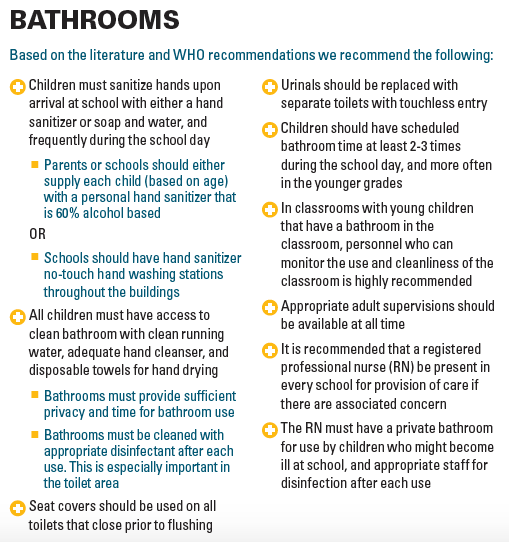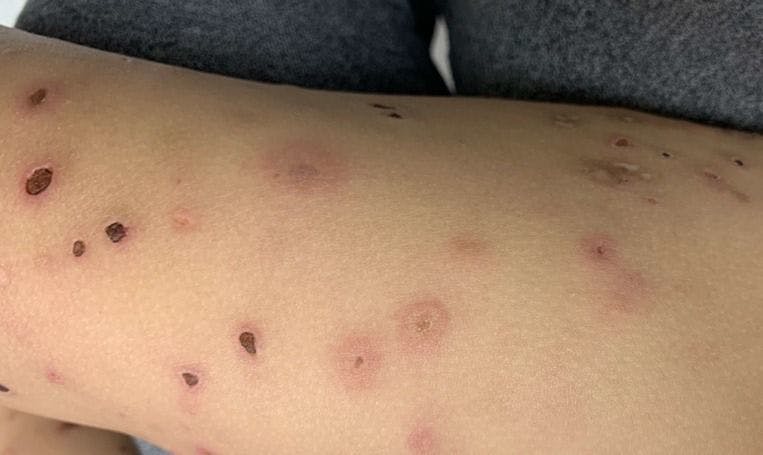Safe return to school: A call to action
As fall approaches, one of the biggest questions is: Can children return to school and be in classroom environments that assure health and well-being for all?
On the topic of ‘return to school’ this year, anxiety abounds for parents and children, as well as teachers, school staff and nurses, nurse practitioners (NPs), departments of health and legislators.1 Since school is considered “the work of children,”2 we must carefully consider all aspects of ‘return to school’ in light of the current, unprecedented COVID-19 pandemic. Many compelling questions emerge, but first and foremost the question to address is: Can children return to school and be in classroom environments that assure health and well-being for all?
The National Parent Union conducted an online COVID-19 survey of 500 parents with children from kindergarten through 12th grade on May 4 and 5, 2020.1 Lowe’s data revealed a significant level of anxiety among parents concerning return to school for their children. A New York Times article reported that 6 of 10 parents are considering continuing with home learning rather than sending their children to school in Fall 2020.3 Some of the parental anxiety and decision making by parents may be attributed to uncertainty as the pandemic remains a viable threat throughout our country.
Planning, testing and masks are a critical component for safe return to school
Guidance from the Centers for Disease Control and Prevention (CDC) for opening schools was posted on the CDC website on March, 19, May 19, June, 3, and July 23, 2020.4-6 The guidance emphasizes the importance of school officials and administrators collaborating with local health officials for decision making regarding return to school and decisions about closing schools, while the most recent statement did stress the importance of reopening schools. The initial interim CDC guidelines4-6 did not address two major issues, masks and testing, that must be resolved either locally, or nationally by implementation of best available scientifically based health safety measures prior to any child’s/adolescents return to school. However, the CDC guidance on July 23, 2020 does recommend masks for children and staff in school settings, except those under 2 years old, and those with some medical conditions. Since wearing masks has been met with controversy, the work of health care professionals (HCPs) is to gain the support of parents, children and school personnel to wear masks during school. And, while recommendations presented in this paper are consistent with CDC guidelines and supports wearing masks, it also provides more stringent considerations for testing school personnel and children. All HCPs realize the ever evolving and changing health care recommendations as the pandemic moves across the country and the world. Thus, what is considered best practice today based on the available evidence, may be shown to be incorrect tomorrow. Making reasonable changes to tackle the twists and turns that emerge every day in this pandemic is a major challenge. Health care professionals at the local, state, regional, in helping non-HCPs make sensible decisions based on scientific data to protect all individuals. Return to school decisions must be based on the science with the overall goal of the health and well-being of the children/adolescents, the school personnel and the community as a whole. One size and one decision will not fit all.
Cleaning and handwashing

The CDC guidance on COVID-19 from July 23, 2020 supports using “cloth face coverings” to prevent the spread of the COVID-19 virus, and includes in their practical recommendations that schools put “cloth face coverings on school supply lists and provide cloth face coverings as needed to students, teachers, staff, or visitors who do not have them.”6 Indeed, the scientific evidence from COVID-19 public health measures supports wearing masks as the new norm for all adults and for all children older than 2 years. Thus, we believe that wearing masks is an essential component of safe return to school. However, children with chronic illnesses, including pulmonary conditions, and those with disabilities may be advised by their physicians and NPs, not to wear face masks. Thus, some protection for children, who are too young to tolerate wearing a mask or are unable to wear masks, may be provided by other children and school personnel who can safely wear face masks in school settings.
Common areas/shared items

The CDC guidance of July 23, 2020 also states that “[The CDC] does not currently recommend universal symptom screenings to be conducted by schools.”6 School NPs and school nurses are educated on public health screening measures and are ideally suited to appropriately screen students and all school personnel prior to entering school for the purpose of preventing exposure of individuals with COVID-19 or any communicable disease symptoms from spreading the virus to contacts at the school. The value of having a school nurse for every school was supported by the AAP policy statement in June 2016.7 In this pandemic, the school nurse is an essential part of the healthcare team (eg, private practice physicians, school based health centers, community clinics, and the department of health) overseeing the health of the children and school personnel and should be employed in every school.
Another major concern identified in the original CDC guidance4-6 is the recommendation to close schools for 2 to 5 days when there is a confirmed case of COVID-19 in the school system. Opening and closing schools for 2 to 5 days will be disruptive to everyone. Testing prior to return to school may prevent schools from opening and closing in a chaotic fashion.
The new norm for cleaning classrooms

Plans to reopen schools must be based on local and state public health data as well as primary and secondary prevention strategies that minimize the potential for viral spread, and avoid a cycle of frequent opening and closing of school systems due to outbreaks of COVID-19.3 The authors believe that testing of students and school personnel prior to reopening schools is the cornerstone of primary and secondary prevention strategies. And while the most recent CDC guidance does not recommend universal testing of children and staff, it however, proposes other testing strategies based on local and state data.8
When the pandemic began, data from other countries led health care providers to believe that children were less affected by COVID-19 but may be asymptomatic carriers.
However, as the pandemic spread in the United States and Italy, there were news reports of chronically ill children hospitalized with severe symptoms. The most troubling occurrence is the new presentation of the COVID-19 complication of the syndrome, Multisystem Inflammatory Syndrome in children (MIS-C).9 The etiology of MIS-C remains unclear. According to reports from the CDC, children who developed MIS-C may have been infected weeks before the appearance of MIS-C symptoms, and/or were symptomatic carriers.
Thus, based on these presentations of COVID-19 in children, testing strategies for children must be considered on all levels to protect all children, school personnel, and the communities in which they live. As of this writing, data for widely testing children for COVID-19 in the United States is non-existent.
Bathrooms

Innovation is an outcome of a crisis. New, non-invasive methods for testing for COVID-19 in children should be developed. Saliva sample testing may be a reasonable solution that can be developed, and, as of this writing, is under investigation as a point-of-care test.
Once testing policies and methods are in place, only then can we proceed with developing other policies that address a safe school environment for children and adolescents, and all school personnel that work every day to educate and care for our children/adolescents.
Screenings are critical to safely reopen schools
Children have been out of school since March 2020 and may not have had their usual access to health care throughout this pandemic. Screenings to identify problems in physical, emotional, social, and behavioral health are a critical strategy for the design and implementation of effective strategies for healthy children. Thus, we encourage all HCPs, including school nurses, to assume a leadership role in the design and implementation of screenings for the identification of children and school personnel who may present with problems that may have arisen during stay-at-home orders (eg, anxiety, school phobia, etc.).
Classroom innovations and social distancing

Screening is a critical part of the process for prevention of transmission of COVID-19 within school systems. An innovative, reliable method for screening children and school personnel prior to going to school each day should be implemented. Some health care systems and other clinical practices have already implemented the use of a web-based application or ‘app’ that can be used to screen for temperature and emerging symptoms one-hour before reporting to work each day. This screening tool asks the individual to report the morning temperature, and also asks other pertinent questions about symptoms and possible exposure to an individual with COVID-19. If negative, the employee reports to work. If any portion of the screening is positive, the individual does not report to work that day. For parents who do not have access to cell phones or apps on their devices, a plan should be in place for the parents to call into the school and report the information to be reviewed by the school nurse prior to the children leaving for school. Once at work (school) and before entering the workplace (school environment), a second temperature screening is recorded. Such an app for school-based screenings for children and school personnel can easily be developed and implemented as best practice for early identification of possible COVID-19 exposure and/or infection for healthy children.
Bathroom issues for children
It has been theorized that COVID-19 viral shedding may persist for longer periods of time through the gastrointestinal tracts of in children.10 It is believed that children may be asymptomatic carriers and may shed the virus for days or even weeks, but too little testing has been done. Schools must be vigilant in preparation of the bathroom space of children and school personnel, preparing for the worst-case scenario. It is important for school systems to be proactive, rather than reactive. Leadership of school nurses and nurse practitioners is essential in policy preparation and enactment of policies for bathroom use.
Frequent cleaning and maintenance of modern bathrooms will reduce risks shedding and must be instituted prior to opening schools, and continue throughout the school day. Measures to help children become comfortable in the bathroom must be part of the curriculum. Soap, running water, and a clean toilet must be established.11 Bathrooms may increase risk of disease transmission without structural change (proper toilet design, adequate soap and water, frequent cleanings). Proper implementation of a plan will enable children and staff to better understand how to prevent other diseases (including influenza and other common gastrointestinal diseases), which should also help change attitudes and establish new norms.
Call to Action for Educational Equality
COVID-19 brought to the forefront nationwide educational inequality. As HCPs, we know the importance of being lifelong learners and the importance of early childhood education and continued excellence in education throughout the K through 12 years. It was distressful to hear many parents report that their children did not have access to computers, tablets and/or the internet at home to continue their education virtually. To achieve meaningful societal change, social justice and educational parity, we encourage educators, parents, and all community members to analyze the local educational needs and to plan accordingly to meet the needs of all students.
Conclusion
As Erik Erickson said, “School is the work of children.”2 We value the education our children receive throughout the US each year preparing the children to develop into healthy, kind, valuable, innovative and productive members of society in whatever careers and professions they choose. The immediate closing of schools at the onset of the COVID-19 pandemic has further enlightened everyone on the value of educators and the school systems. All HCPs want children to return to school safely and free of the threats of contracting COVID-19 within the school environment. Thus, our recommendations are based on the best available evidence as of this date and time. Screening, non-invasive testing, masks for all children over 2-years old, eye protection, social distancing, cleaning, transportation, and bathroom use are critical to the health and well-being of the children, all school personnel, their parents, family members and the community in which they live and grow.
References
1. Lowe, B. New poll: Two-thirds of parents support keeping schools closed ‘until they are certain there is no health risk’. Published May 11, 2020. Accessed June 3, 2020. https://www.the74million.org/new-poll-two-thirds-of-parents-support-keeping-schools-closed-until-they-are-certain-there-is-no-health-risk/
2. Erikson, EH. Childhood and society (2nd ed.). 1963. W. W. Norton & Company.
3. The Editorial Board. How to reopen America’s schools. The New York Times. Published June 6, 2020. Accessed June 17, 2020. https://www.nytimes.com/2020/06/06/opinion/coronavirus-schools-reopen.html?referringSource=articleShare
4. Center for Disease Control and Prevention. Interim Guidance for Administrators of US K-12 Schools and Child Care Programs Plan, Prepare, and Respond to Coronavirus Disease 2019 (COVID-19). Published April 12, 2020. Accessed June, 3 2020 https://www.cdc.gov/coronavirus/2019-ncov/community/schools-childcare/guidance-for-schools.html
5. Center for Disease Control and Prevention. National Center for Immunization and Respiratory Diseases (NCIRD), Division of Viral Diseases. Coronavirus Disease 2019 (COVID-19). Considerations for Schools. Published May 19, 2020. Accessed June 3, 2020. https://www.cdc.gov/coronavirus/2019-ncov/community/schols-childcare/schools.html
6. Centers for Disease Control and Prevention. Coronavirus Disease 2019 (COVID-19). K-12 Schools and child care program. Published June 3, 2020. Accessed June 17, 2020. https://www.cdc.gov/coronavirus/2019-ncov/community/schools-childcare/schools-faq.html?deliveryName=USCDC_2067-DM29945
7. AAP Council on School Health. Role of the School Nurse in Providing School Health Services. Pediatrics. Published June 2016. Accessed July 12, 2020. Accessed from https://pediatrics.aappublications.org/content/137/6/e20160852
8. Center for Disease Control and Prevention. Coronavirus disease 2019 (COVID-19). Interim considerations for K-12 school administrators for SARS-CoV-2 testing. Published June 30, 2020. Accessed July 12, 2020. https://www.cdc.gov/coronavirus/2019-ncov/community/schools-childcare/k-12-testing.html
9.Center for Disease Control and Prevention. For Parents: Multisystem Inflammatory Syndrome in Children (MIS-C) associated with COVID-19. Published May 20, 2020. Accessed June 10, 2020. https://www.cdc.gov/coronavirus/2019-ncov/daily-life-coping/children/mis-c.html
10. Hindson J. COVID-19: faecal-oral transmission?. Nat Rev Gastroenterol Hepatol. 2020:17(5):259. doi:10.1038/s41575-020-0295-7
11. WHO Water, Sanitation and Hygiene strategy 2018-2025. Geneva: World Health Organization; 2018 (WHO/CED/PHE/WSH/18.03). License: CC BY-NC-SA 3.0 IGO Published 2018. Accessed June 28, 2020. https://apps.who.int/iris/handle/10665/274273

Having "the talk" with teen patients
June 17th 2022A visit with a pediatric clinician is an ideal time to ensure that a teenager knows the correct information, has the opportunity to make certain contraceptive choices, and instill the knowledge that the pediatric office is a safe place to come for help.
























